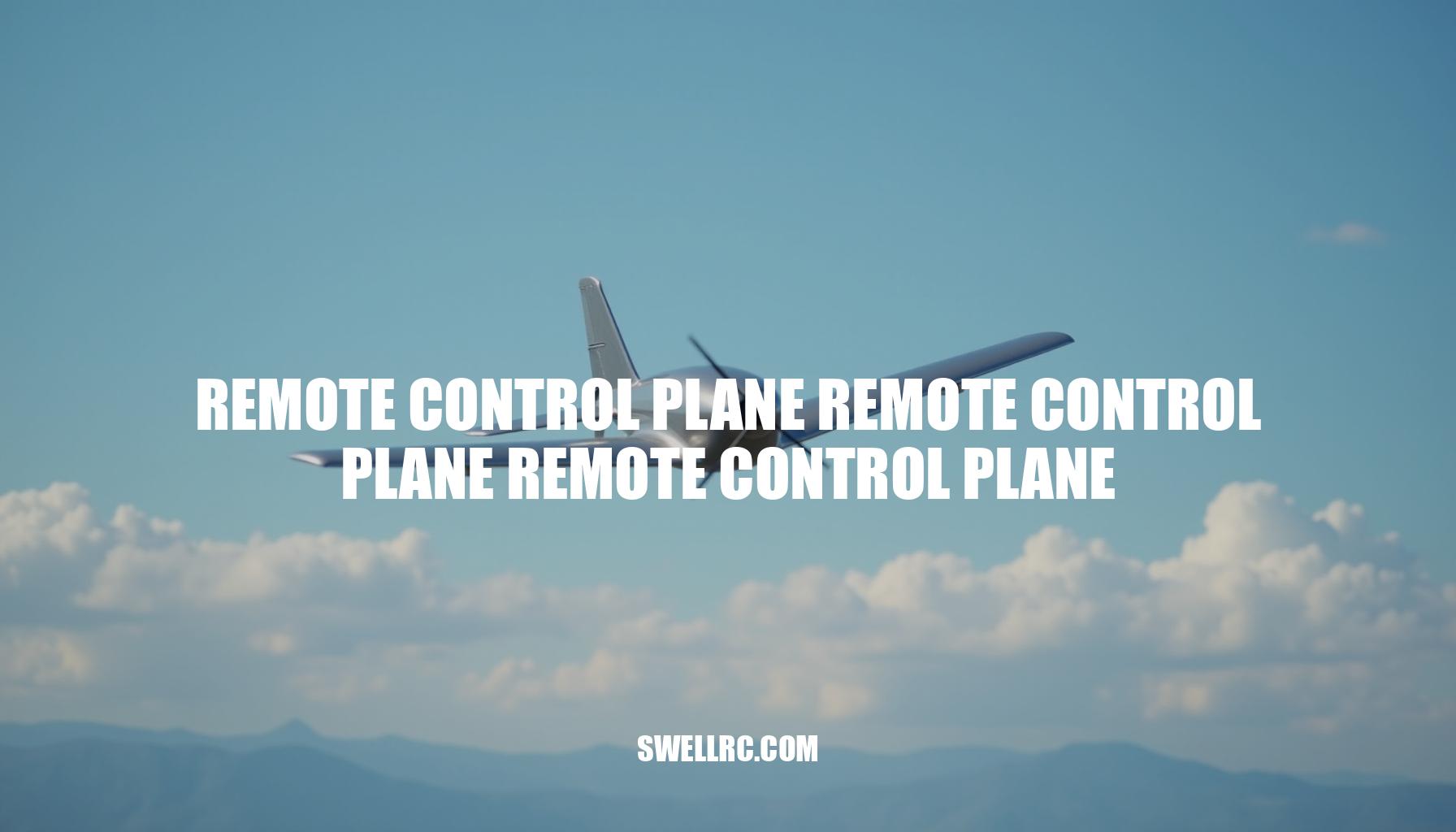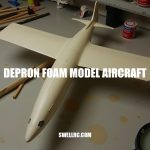The Ultimate Guide to Remote Control Planes
The first time I watched a scale fighter jet slice through the afternoon sky, I felt that undeniable spark: if a remote control plane could make my heart race from the ground, just imagine what it would be like to command one myself. My initial foray into the RC aviation hobby was a cocktail of trembling thumbs and pure wonder—my first test flight ended with a bumpy landing but left me grinning uncontrollably. That moment sealed my fascination with RC planes—the perfect marriage of technology, creativity, and skill that transforms simple materials like foam, balsa wood, and electronics into living motion.
After countless hours spent crashing, calibrating, and fine-tuning, I came to realize that a remote control plane is far more than just a toy—it’s a dynamic classroom in flight.
From understanding how transmitters communicate with receivers to witnessing servos animate control surfaces, and unraveling why motor choices and material selection impact every second of performance, the world of radio control aircraft is as intricate as it is thrilling. In this deep dive, we’ll explore the distinct types of model airplanes—from agile foam fighters to graceful balsa gliders—delve into advancements in endurance and range, and outline a smart upgrade path from beginner RC flight to mastering electric RC jets. By the end, you’ll grasp every layer of this captivating hobby, from paper prototypes to advanced jets, empowering you to confidently select your next remote control plane with a clear purpose and excitement.
Section One: Understanding How Remote Control Planes Work
Think of the transmitter and receiver as the nervous system of your radio control aircraft. The transmitter (usually operating on 2.4 GHz for interference resistance) sends precise radio signals to the receiver onboard the plane. The receiver then relays these commands to servos, tiny electrical muscles that move the flight surfaces: the ailerons roll the plane, the elevator pitches the nose up or down, the rudder yaws left and right, while the throttle controls power output.
The power system includes an Electronic Speed Controller (ESC) managing the brushless motors, all energized by a LiPo battery, delivering clean and reliable thrust. Understanding each component’s role helps demystify how your inputs translate into graceful or exhilarating flight.
Here’s a quick comparative table to help beginners grasp the main materials and power systems encountered in remote control aircraft types:
| Component | Options | Characteristics | Best For |
|---|---|---|---|
| Airframe Materials | Foam (EPO/EPP), Balsa, Composites, Paper/Foamboard |
|
Beginners: Foam; Hobbyists: Balsa; Advanced: Composites; Experimenters: Paper |
| Power Systems | Electric (brushless), Nitro (glow fuel), Gas (petrol) |
|
Trainers to jets: Electric; Nostalgic or realistic sound: Nitro; Large scale flights: Gas |
To put it simply, when you move your transmitter sticks, radio waves carry your commands to the receiver, which tells servos how to move the surfaces. The ESC powers your brushless motor according to throttle signals, and your LiPo battery feeds the entire system. This precise dance amplifies your thumb’s subtle movements into the beautiful art of flying a remote control aircraft.
And once you see those ailerons and rudder respond instantly, everything makes sense—each component perfectly tuned to the joy of flight.
Section Two: Testing and Comparing RC Plane Types: From Foam Fighters to Jet Legends
During an exciting day of testing various electric RC jets and gliders in a breezy field, I gained invaluable insights into the nuances of control precision and durability across different model categories, including foam fighter jets, balsa gliders, and advanced scale models like the SR-71 Blackbird. Each brings a unique flavor to the RC flying experience and serves different pilot skill levels and preferences.
To start, foam fighter jets like the popular F-35 RC jet offer spectacular silhouettes paired with surprisingly smooth handling for delta-wing designs. These models reward pilots who invest time in proper airframe tuning—adjusting the center of gravity (CG), control rates, and expo settings translates into razor-sharp control precision, making knife-edge passes both achievable and immensely satisfying. Plus, foam’s natural shock-absorbing properties provide notable durability, forgiving those aggressive bank-and-yank maneuvers without frequent repairs.
The budget-friendly KT RC foam fighter jet is another solid choice for pilots wanting thrills without breaking the bank. It features durable foam construction and straightforward hand launches, though its performance shines brightest when paired with fresh, high-C LiPo batteries. This combination boosts speed and responsiveness, elevating the flying experience of what might otherwise feel like a mediocre model.
Switching gears, balsa gliders embody meditation in motion. Their long, graceful flights and gentle landings teach invaluable lessons in energy management and thermalling techniques—perfect for those seeking to master finesse over brute force. These models emphasize patience and throttle precision, requiring a softer touch, and reward with extended soaring that enhances pilot sensitivity and real-world soaring feel.
Stepping up to the pinnacle of electric RC jets, the SR-71 Blackbird model is designed for experienced hobbyists who crave speed and realism. Fast, sleek, and demanding, this model requires excellent launch technique, solid sticksmanship, and a wide-open, clear sky. When trimmed precisely and flown with discipline, the SR-71 delivers breathtaking high-speed performance and authentic scale realism, making every flight an adrenaline-packed adventure.
| Model | Difficulty | Speed | Realism |
|---|---|---|---|
| F-35 foam EDF | 3/5 | 4/5 | 5/5 |
| KT foam fighter | 2/5 | 3/5 | 3/5 |
| Balsa glider | 1–2/5 | 1–2/5 | 4/5 |
| SR-71 EDF | 4–5/5 | 5/5 | 5/5 |
Key takeaways for RC enthusiasts aiming to upgrade or diversify their fleets:
- Foam fighter jets blend forgiveness and performance, making them perfect for practicing aggressive maneuvers without enduring constant dings.
- Balsa gliders provide a serene flying experience that enhances throttle control and energy management skills.
- Advanced electric RC jets like the SR-71 Blackbird demand a higher skill level but reward with unparalleled speed and authentic flight behavior.
- Regardless of model, tuning your airframe and investing in good batteries can significantly enhance flight quality—even turning mediocre gliders or jets into enjoyable performers.
By understanding these dynamics, hobbyists can make informed decisions based on their skill levels and flying ambitions, ultimately elevating every RC flying session.
Section Three: Performance, Range, and Build Innovations
Diving into the performance metrics of remote control (RC) aviation reveals a fascinating blend of physics, engineering, and pilot skill. Speed, range, and battery endurance are primarily dictated by airframe efficiency, propulsion systems, and disciplined throttle management. For example, a well-trimmed trainer aircraft typically cruises between 30–50 mph, while electric ducted fan (EDF) jets can sprint in the 70–120 mph range, and turbine-powered monsters push these boundaries even further, albeit demanding rigorous safety protocols.
Control is maintained through typical 2.4 GHz radio links, ensuring wireless frequency stability within a visual line of sight—commonly 0.5 to 2 km depending on environmental conditions and equipment quality.
Here’s a quick endurance snapshot that highlights the diversity of flight profiles across popular RC categories:
- EDF jets: 6–12 minutes — battery-hungry but exhilarating bursts of speed and agility.
- Sport prop planes: 12–25 minutes — optimized with smart throttle control for balance between power and endurance.
- Efficient gliders: 30–60 minutes — with skillful use of thermals extending flight time significantly beyond motor endurance.
The ongoing brushless motor evolution and high-efficiency electronic speed controllers (ESCs) have enhanced thrust delivery and integrated telemetry feed data to pilots for improved real-time situational awareness. This, coupled with meticulous propeller optimization — adjusting diameter, pitch, and blade count — allows tailoring thrust curves and noise signatures precisely to pilot or mission demands.
| Innovation Area | Advancement | Impact |
|---|---|---|
| Airframe Design | Blended winglets, optimized airfoils, lightweight, and stiff spars | Superior lift-to-drag ratios, improving overall range and battery endurance |
| Radio Technology | Modern spread spectrum protocols (FHSS/DSSS) | Enhanced interference resistance ensuring consistent control signals |
| Materials & Structure | Use of composites in frames and components | Reduces weight while increasing strength and durability, pushing performance limits |
One remarkable frontier is highlighted by the biggest remote control airplane projects. These marvels showcase what’s achievable using composite structures, redundant power systems, and meticulous weight management to push the envelope of scale, performance, and reliability.
Equally important is craftsmanship that reflects in brands like World Models RC planes, which continuously refine a delicate balance between scale authenticity, weight economy, and honest flight characteristics. They prove that elegance and high performance are not mutually exclusive.
Did you know?
- Small shifts in center of gravity have outsized effects in flight; starting slightly nose-heavy enhances stability, with gradual adjustments improving maneuverability.
- A modest propeller swap can boost climb rate by 5–10% without requiring motor changes.
- Smooth foam skins and sealed control surface gaps can add valuable minutes of flight time by minimizing drag.
In sum, advances in aerodynamics, propulsion innovation, materials science, and radio communication continue to elevate RC aviation to exciting new heights, driven by a passionate and inventive community pushing the limits of what’s possible.
Section Four: Choosing the Perfect Plane: From Hobbyist to Pro
Choosing the best remote control plane for adults or beginners begins with understanding your “why.” Are you aiming for calm afternoon flights with smooth landings? Or do you crave adrenaline-pumping aerial maneuvers and scale-accurate warbirds? Your goals will shape the perfect match between your skill level, budget, and the plane’s purpose—whether that’s racing, photography, acrobatics, or scale modeling.
For those new to beginner RC flight, starting with a high-wing trainer equipped with gyro stabilization and durable foam is essential. Models like the Volantex RC airplane offer rock-solid trainers featuring predictable handling—perfect for that first takeoff and those greased landings every novice dreams about.
Once you’re comfortable and ready to explore more, stepping up to a mid-tier sport plane like the Leambe plane opens up new possibilities. This reliable option delivers mild aerobatics and handles breezier days well, making it a great bridge to more dynamic flying experiences.
If precision aerobatics or serious maneuvers are your passion, consider Pilot RC planes. These boast crisp control geometry and durable build quality, tailored for pilots who want tight, responsive control during advanced 3D flying or pattern routines.
For those fascinated by scale EDF fighters or warbirds, patience is key: only take on these challenging models after you’ve achieved consistent, confident landings and refined your orientation skills. These planes deliver adrenaline and authenticity but demand experience.
Here’s a handy decision guide to match your skill and goals:
- Absolute beginner: High-wing trainer with gyro stabilization and durable foam construction.
- Ready for more: Mid-tier sport plane (e.g., Leambe) with modest throw settings and bigger batteries.
- Aerobatics/precision: Pattern or 3D platforms (like Pilot RC) featuring powerful servos and stiff airframes.
- Scale EDF/warbirds: Only after consistent landings and good orientation skills are mastered.
As your skills grow, consider these elements in your upgrade path and accessories:
- Radio upgrades: Transition from basic 6-channel radios to programmable units with telemetry feedback for enhanced control and data.
- Batteries and charging: Learn proper LiPo care, invest in a balance charger, and keep multiple battery packs ready to extend your flying sessions.
- Propulsion tweaks: Experiment with different propellers or slightly higher C-rate battery packs within specs to achieve better throttle response and flight punch.
- Flight aids: Add a lost-model buzzer, upgrade to better landing gear, and choose durable props or spinners to minimize damage during rough landings.
Remember always to check local regulations regarding RC aircraft and fly within visual line-of-sight in safe, open spaces to ensure both your safety and that of others. By following this consultative approach, you’ll confidently navigate from your first gentle glide to thrilling aerobatics and beyond, making the most of your remote control flying adventures.
Section Five: My Essential Tips for First-Time Flyers
Embarking on your journey into RC flying can be both thrilling and challenging. Learning from experience, here’s a firsthand guide packed with RC flying tips designed to help you avoid common beginner pitfalls, master takeoffs, and achieve smooth landings. These lessons come from my early flights and crashes, each refining my approach and skills.
- Fly the sim first: Spending 2–5 hours on a flight simulator can save your airframes and wallet by building muscle memory without risk.
- Pick calm weather: Choose flying sessions with winds under 8–10 mph to create safe flying environments perfect for beginners.
- Check CG every time: Ensuring your center of gravity is slightly nose-heavy is crucial; it beats the dangers of tail-heavy disasters.
- Set dual rates and expo: Taming your controls with gentle inputs to start, then adding authority later, helps you build confidence and control.
- Perfect your launch/takeoff: Use a level toss or a smooth throttle-up on a long, clear path—key components of a solid takeoff technique.
- Land with power: Maintaining a whisper of throttle keeps the wing flying smoothly—avoiding chopping throttle to zero too early prevents abrupt stalls during landing.
- Build a preflight ritual: Always confirm surfaces are correct, link quality is reliable, battery secured, and your timer set—forming a reliable preflight checklist.
- Mind orientation: Practice flying high, large circuits and turn gently toward yourself to avoid disorientation—a must-know for beginner RC flight.
- Learn to bail out: If your approach looks messy, go around; pride can cost more than patience in safe flying environments.
- Join a club or mentor: Experienced pilots can help trim your plane and calm your nerves within minutes, accelerating your learning curve.
My first crash was a harsh lesson—I stalled base-to-final by pulling too much elevator and cutting throttle prematurely.
From that, I learned to keep a touch of power, bank shallow, and trust the wing to work. Each mistake became a teachable moment, and those fixes shaped my muscle memory for safer, smoother flights ahead.
Conclusion: From Ground to Greatness – Why Remote Control Planes Hook Us for Life
In the vibrant world of the RC aviation hobby, every whisper of your transmitter breathes life into the wing movements of your remote control plane, transforming imagination into exhilarating reality. We’ve journeyed through the fascinating details of model variety, from simple foam fighters to iconic electric RC jets, each offering unique thrills and shaping your piloting skills. Understanding the importance of continuous improvement—whether in materials, motor choices, or performance enhancements—empowers you to push the boundaries of what’s possible.
This community isn’t just about flying; it’s a dynamic network of creative experimentation, tinkerers, storytellers, and passionate pilots who celebrate each small victory and every big leap forward. Together, they illuminate the path from your first trainer aircraft to confident, purposeful flying with a purpose. The excitement, patience, and creativity found here make every successful flight feel like sheer magic.
As you continue to explore, innovate, and share, remember that the horizon is no limit—it’s an open invitation to keep discovering in this wonderful hobby. The future of remote control planes is bright, with innovations shaping the next generation of RC technology, promising even greater adventures ahead.
So, keep your curiosity soaring and your passion ignited; the RC community awaits your next flight.
Frequently Asked Questions
- What’s the best remote control plane for beginners?
A stable, high-wing electric trainer with a gyro (stabilization) is ideal. Look for durable EPO foam, tricycle landing gear, and gentle control throws. As a reference class, the Volantex RC airplane offers predictable handling that makes first takeoffs and landings less stressful. - How do you control a remote control plane?
A transmitter sends commands to the onboard receiver, which moves servos: throttle controls speed, elevator controls pitch, ailerons roll the plane, and rudder yaws it. Beginners start with gentle rates and some expo. Keep turns shallow and maintain a bit of power in approaches to prevent stalls. - What materials are used to build RC planes?
Common materials include EPO/EPP foam (durable and easy to repair), balsa wood (light, stiff, great glide), and composites like fiberglass or carbon (strong and precise but costlier). DIY builders also use foamboard, 3D-printed parts, and even paper for early prototypes. - How long does a remote control plane battery last?
Flight time varies by airframe and throttle use: EDF jets typically fly 6–12 minutes, sport prop planes 12–25 minutes, and efficient gliders 30–60 minutes (longer with thermals). Battery health, prop choice, and aerodynamic cleanliness all affect endurance. - What is the difference between nitro, electric, and gas RC planes?
Electric: clean, quiet, easy to maintain, huge variety. Nitro (glow): classic sound and smell, more tuning and maintenance, quick refuels. Gas (petrol): suited for larger planes with long flight durations, requires careful setup. Choose based on size, budget, and the experience you want. - Can you build your own RC plane at home?
Yes. Many pilots start with foamboard or balsa kits, adding a brushless motor, ESC, servos, receiver, and a LiPo battery. Prototyping with paper or foamboard helps you learn electronics and aerodynamics before investing in higher-end materials. Always test in open, safe areas. - What’s the most powerful RC jet available?
Turbine-powered RC jets are the most powerful, with speeds well over 200 mph in expert hands. They require advanced skills, rigorous safety practices, and compliance with local regulations. EDF (electric ducted fan) jets provide high performance with simpler operation for most hobbyists. - How far can remote control planes fly?
With modern 2.4 GHz radios, reliable control typically extends within visual line of sight—often 0.5–2 km, depending on environment and equipment. Long-range systems can reach farther, but you must follow local regulations and maintain safe, line-of-sight operation.



